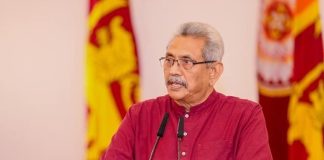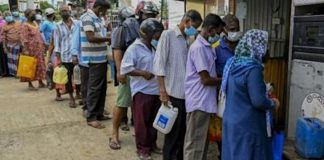Sri Lanka considers incentives for expatriate workers not using undiyal or...
ECONOMYNEXT – Sri Lanka is considering to grant tax relief and other benefits like housing loans for expatriate workers who sends their earnings through the official bank network Minister of Labour and Foreign Employment said.
Money is moving to unofficial channels such as Undiyal at higher premiums because the central bank is printing money creating forex shortages in the official banking system and exchange controls have been placed forcing them to go a free market at higher rates.
Sri Lanka’s official remittances have fell 52 percent in April to 249 million US dollars, compared to a year ago while they have fallen by 57 percent to 1 billion US dollars in the first four months of 2022, compared to the same period last year.
Manusha Nanayakkara, the newly appointed Minister of Labour and Foreign Employment has planned ambitious 500 million US dollar per month to boost foreign currency liquidity in the country.
“If we can increase it back up to 500 million US dollars, with these expatriate workers sending the money legally, we can solve some fundamental problems in the country,” Nanayakkara told a weekly cabinet briefing.
Nanayakkara said, the discussion is being held to give expatriate workers tax reliefs, duty relief, interest free housing loans to encourage them.
“And we will also start giving them discount cards to increase their trust and send money through legal procedures,”Nanayakkara said.
Sri Lanka is grappling with its worst economic crisis in the history. The dollar shortages have led to long queues for fuel and cooking gas. The dollar shortage has also deprived people of adequate medicines, cement, milk powders, and some foods which are imported.
“To solve the economic crisis we have at the moment, while getting the income of exports, one of the main ways to increase the foreign currency without taking loans is by increasing the foreign remittances,” Nanayakkara said.
“Due to various reasons, with these remittances not coming through legal channels. The remittances we had around 600 – 700 million US dollars has gone down to around 230 million US dollars by March, 2022.”
Until this month, a part of the unofficial remmittances were going for open account imports including for imports of oil. However buraucrats prefer money to come through the monopoly of the banking system.
Banking system also has a high transactions costs of about 10 to 15 rupees between buy and selling rates. (Colombo. June 07/2022)
Sri Lanka must rebuild agriculture sector immediately to prevent food shortages:...
ECONOMYNEXT – Sri Lanka must begin rebuilding its agriculture sector immediately to forestall looming food shortages and to retain the international market for export crops, Prime Minister Ranil Wickremesinghe said.
“We are losing the international market for our export crops. Action must be taken to prevent this. [Inorganic] fertilizers are needed to boost local agriculture. It costs 600 million US dollars a year to import fertilizer for paddy, vegetables, fruits, other major crops as well as our tea, rubber, coconut and export crops.
“Since manure has to be applied from time to time from the beginning to the end of a harvest, it is essential that fertilizer is exported without any shortages. We must ensure that no money or effort will be wasted,” Wickremesinghe said in a statement made to parliament on Monday (07).
Sri Lanka’s agriculture sector has taken a catastrophic hit from President Gotabaya Rajapaksa’s ill-conceived overnight shift to organic farming. Compounded by the country’s worsening forex crisis, Sri Lanka is now looking at a possible food shortage around October, as warned by several government officials including Agriculture Minister Mahinda Amaraweera.
“Our harvest has declined in the past several months. We have to face this situation at and we have to work hard from this point onwards to ensure the next harvest is a success. That harvest, however, will be available by the end of February 2023,” said Wickremesinghe.
“In terms of rice, our country’s annual rice requirement is 2.5 million metric tons. But we have only 1.6 million metric tons of rice in stock. This is not limited to paddy but applies to many other crops. In a few months we will have to face serious difficulties and shortages in terms of our diets. We need to import food items to meet our daily requirements. It costs about 150 million dollars a month,” he said.
Meanwhile, the cabinet of ministers on Monday (06) approved a proposal to provide 150,000 MT of urea, 45,000 MT of MOP and 36,000 MT of TSP fertilizer for farmers for the next Maha cultivation season through the Ceylon Fertilizer Company and the Colombo Commercial Fertilizer company.
Related:
Sri Lanka state firms to buy 230,000MT fertilizer for next cropping season: Minister
(Colombo/May07/2022)
‘Economy started to decline when 2019 Tax system was abolished’ –...
Sri Lanka to present interim budget cutting cutting capex: PM
ECONOMYNEXT – Sri Lanka will present an interim budget cutting capital spending and directing money for essential public services and relief for the poorer sections of society, Prime Minister Ranil Wickremesinghe said.
“Some projects will have be delayed or halted,” Wickremesinghe, who is also Finance Minister told parliament.
“We have to have a safety net for the weak.”
He said about 700 million US dollars in spent on transfers including pensions. It will be increased to 850 million US dollars wand if possible about 900 million US dollars.
About 100 billion rupees has been spent on Samurdhi relief but it has to be increased by around 150 billion to around 350 billion rupees, he said.
After Sri Lanka’s soft-peg with the US dollar collapses people are facing high food prices.
“By 2022 we have to stabilize the economy,” Wickremesinghe said. “In 2024 we can give some stimulus for growth. By 2025 we want to have a primary surplus in the budget.”
“All future government’s must keep to the plan.”
Sri Lanka is currently facing the worst currency crisis in the history of the country’s 72-year old intermediate regime central bank after stimulus triggered three currency crises in 7 years.
Each stimulus is followed by an economic shock.
After two years of stimulus, economy is set to contract in 2023.
“The central bank estimates the economy to contract 4 to 5 percnet,” Wickremesinghe said. “The IMF thinks in will be worse around 6.9 percent.
For 2023 about a trillion rupee may have to be printed, he said.
Agricultural loans to farmers who have land below two hectares will be written off he said.
Promises of loans write-off usually triggers a wave of defaults in Sri Lanka endangering banks and discouraging farming loans in the future, critics have said.
State urban housing units where occupants are now on rent will be given to them to own on a concessionary terms.
He said many were built by the father of the current opposition leader Sajith Premadasa. (Colombo/June07/2022)
Sri Lanka Cricket to donate ticket money from Australian tour to...
ECONOMYNEXT – Sri Lanka Cricket (SLC) has decided to donate the entire revenue from ticket sale of the upcoming Australia tour of Sri Lankan games to the welfare of the people suffering from the ongoing economic crisis, a SLC spokesman said.
Eight games between the two countries will be played as day and night games, which are expected to play under flood lights and consume more power than only day light games. Two one-day games will be played in Kandy, Pallekele ground, while other six matches in the shorter version of the game will be played in Colombo.
The SLC’s executive committee has taken the decision to donate the money following a request made by the Sports Minister Roshan Ranasinghe.
“The entire ticket money from the five one-day games, three T20 games, and the two tests will be donated for the people to have their essential items,” the he said.
The first Twenty20 (T20) starts on June 7 at 1900 hours. The tour goes until end July.
SLC has already made nearly 2 million US dollars of donation for two hospitals in Colombo to buy medicines.
Sri Lanka is facing its worst economic crisis in its history with people are facing shortage of essential goods including fuel, cooking gas, milk powder, medicines, and foods.
Many people are forced to wait in queues for hours or days to get their essentials amid President Gotabaya Rajapaksa’s government has exhausted the country’s dollar reserves. Tens of thousands of people have lost their jobs or earning less because of lower demand and closure of businesses. (Colombo/June 06/2022)
“I can’t go as a failed president,” – Sri Lankan President...
Sri Lanka explains regime which is still creating forex shortages
ECONOMYNEXT – Sri Lanka’s central bank has explained its exchange rate regime, which is still creating forex shortages amid a failed attempt to float the currency after mis-targeting interest rates for two years.
Sri Lanka has a soft-peg or intermediate regime (now called a flexible exchange rate) which loses credibility quickly and collapses frequently when liquidity is injected as money and exchange policies conflict.
The rupee collapsed steeply after March 2022, as an attempt was made to float the currency with a surrender requirement (forced dollars sales to the central bank) making the regime a peg and forcing the currency down, critics have said.
The central bank is now intervening in the market with surrendered and borrowed dollars, preventing a clean float from taking place.
Sri Lanka’s rupee has fallen from 4.70 to the US dollar to 365 to the US dollar since the soft-peg was set up in 1950.
The central bank introduced a ‘guidance rate’ last month saying transactions were taking place at different rates and there was no price transparency.
Later open account imports were also banned, raising fears over food imports if the banks do not allocate dollars for food quickly.
In 2022 Sri Lanka is suffering the worst currency crises in the history of the intermediate regime central bank.
However the central bank has taken the key step of raising rates which will reduce domestic credit, private investments and therefore imports, drive more money to the deficit, and reduce money printing which is creating forex shortages.
Sri Lanka’s public are generally net savers, cannot print money, and are incapable for creating balance of payment problems, either through imports, undiyal transactions, holding foreign currency in hand or maintaining dollar deposits, unless such transactions are directly or indirectly re-financed by central bank credit and open market operations.
Forex shortages are a problem associated with soft-pegs where outflows exceed inflows through the credit system when money is printed and rupee reserves of individual banks change when interventions are sterilized.
Clean floats also do not have forex shortages. Both clean floats and hard pegs match inflows to outflows at all times.
Related
Sri Lanka rupee to Indonesia’s Rupiah, the consequences of state failure
Monetary regimes that are do not have conflicts involve targeting one anchor (keeping one variable constant like the exchange rate or inflation or until 1971 price of gold) and allow or change monetary policy to maintain it.
The full statement is reproduced below:
06 June 2022
Communications Department
The Current Exchange Rate Arrangement: Background, Positive Impact thus far, and Expected Outcomes
This note is intended to explain to the general public the background to the current exchange rate arrangement, and the positive impact it has already made, and expected outcomes in the period ahead.
The country is facing extremely challenging economic circumstances at present while it is going through the worst balance of payments crisis in history. The Sri Lanka rupee was subject to tremendous depreciation pressure, amidst the shortage of foreign exchange liquidity in the domestic foreign exchange market, warranting a measured adjustment in the determination of the exchange rate in early March 2022, compared to the level that prevailed in the market amidst concerns about the adverse impact of any large depreciation of the exchange rate on the society.
However, the outcome of the exchange rate flexibility that was thereafter allowed following the initial measured adjustment fell short of expectations due to the large overshooting by market forces, reflecting the significant liquidity pressures that prevailed in the domestic foreign exchange market as well as the delay in market correction. This behaviour of exchange rate since allowing more flexibility in March 2022 suggests the need for careful sequencing of measures when allowing flexibility in exchange rate under balance of payments crisis conditions.
Following the excessive depreciation, inflation accelerated significantly through imported prices, while second-round effects of such excessive depreciation on other goods and services were also observed subsequently. Moreover, due to the acute shortage of foreign exchange in the domestic foreign exchange market, along with continuous depreciation of exchange rate, the conversions of foreign exchange by the foreign exchange holders delayed due to expectation of further depreciation and high premium offered in the grey market, thus adding further pressures on the currency.
Meanwhile, the demand for foreign exchange in the grey market thrived to part finance rising import demand outside the banking system, causing further pressures on the currency as well as heightening stresses in the banking system. This significant volatility of the exchange rates drove up the interbank exchange rates as well as customer buying and selling rates in an abrupt nature, causing undue speculation on the currency.
Against this backdrop, limiting the extent of depreciation and excessive volatility became necessary. If remained unresolved, such boundless rate of depreciation of the exchange rate could have led to extremely detrimental impact on overall macroeconomic stability, given the severity of the balance of payment crisis that the country is going through at the moment. Further, during the discussions with the Heads of Treasuries of licensed commercial banks, the need for some guidance to the market from the Central Bank on the degree of volatility of the exchange rate movements was emphasized, while the commercial banks have the prerogative to determine the interbank spot market exchange rate.
In consultation with the market players, the Central Bank commenced providing daily guidance on the degree of volatility (with an allowable two-sided variation margin) to all licensed commercial banks from 13 May 2022 based on exchange rate determined in the interbank market on the preceding day. Although this arrangement is often misinterpreted as ‘pegged exchange rate’ regime, there are clear distinctions between the current transitory arrangement and the pegged exchange rate system. Under the pegged exchange rate regime a fixed middle rate is usually dictated by a central bank, while market driven variable spot rate being considered as the middle rate under the current arrangement.
The implementation of this arrangement has brought in a greater stability in the exchange rate determination in both formal market and grey market thus far, while also minimizing excessive margins prevailed in both markets, and the effects of the same are expected to reflect in the exchange rates used for customer transactions. According to the feedback received from the stakeholders, there exists broader consensus on the current arrangement of the exchange rate, which is market driven with less volatility and more predictability, compared to the earlier arrangement, which experienced excessively volatile of the exchange rate driven more by speculation rather than market forces and economic fundamentals.
The Government and the Central Bank implemented several complementary measures, alongside the current exchange rate arrangement, to correct some of the imbalances observed in the external sector, thereby bringing about stability in the domestic foreign exchange market. Restrictions imposed on open accounts and consignment payments terms have helped curtail activity in the grey market, thereby narrowing the gap between the official exchange rate and the grey market rate. Accordingly, the current exchange rate arrangement is viewed as a more credible mechanism, vis-a-vis an arrangement where grey market activity could operate freely.
Consequently, inflows on account of workers’ remittances to the banking system have gathered pace since the introduction of the new exchange rate arrangement, while conversions have improved. Import expenditure has declined notably in May 2022, compared to April 2022, according to provisional data from Sri Lanka Customs.
Despite the reduction in import expenditure, all possible measures would be taken to secure availability of essential commodities with the expected inflows from multilateral and bilateral sources to the banking system in the period ahead. Given the degree of overshooting of the exchange rate in March 2022, a further market based correction is expected with the deceleration of non urgent import expenditure, alongside increasing inflows to the banking system in terms of workers’ remittances and export proceeds on goods and services, among others.
This improved momentum in the domestic foreign exchange market is expected to consolidate with the progress being made towards reaching the staff level agreement with the International Monetary Fund (IMF) on a funding arrangement, along with the negotiations for bridging finance from other multilateral and bilateral partners.
The Central Bank would like to reiterate that the current arrangement of exchange rate would be reviewed from time to time, and further flexibility would be allowed if need be, once market confidence is restored, supported by envisaged foreign exchange inflows to the country.





